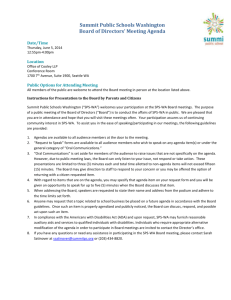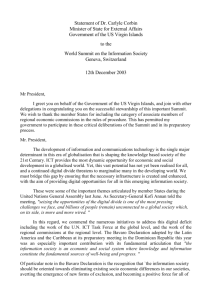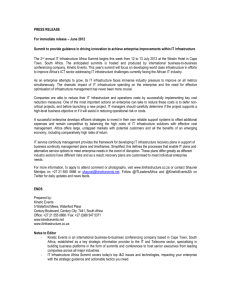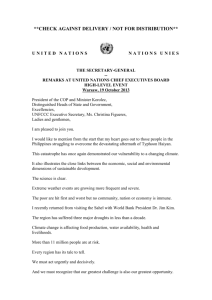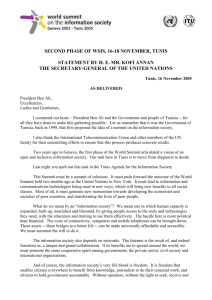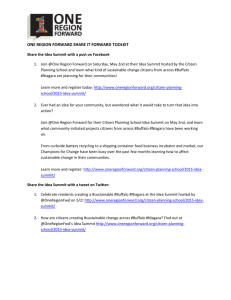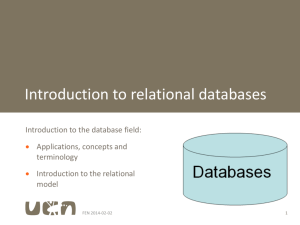WEB 2.0 Framework
advertisement
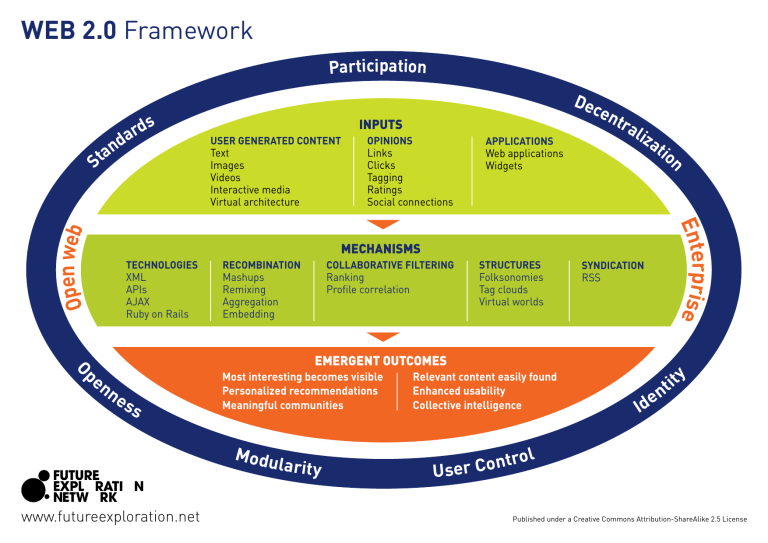
WEB 2.0 Framework FWhj_Y_fWj_ed :[ Y[d jhW i >CEJIH Z h b_p W KI;H=;D;H7J;:9EDJ;DJ EF?D?EDI 7FFB?97J?EDI Z Wj d _e IZmi A^c`h LZWVeea^XVi^dch W d Ij >bV\Zh 8a^X`h L^Y\Zih B:8=6C>HBH J;9>DEBE=?;I MBA 6E>h 6?6M GjWndcGV^ah H;9EC8?D7J?ED BVh]jeh GZb^m^c\ 6\\gZ\Vi^dc :bWZYY^c\ 9EBB78EH7J?L;<?BJ;H?D= GVc`^c\ Egd[^aZXdggZaVi^dc IJHK9JKH;I ;da`hdcdb^Zh IV\XadjYh K^gijValdgaYh IOD:?97J?ED GHH :B:G<:CIDJI8DB:H dd [i i Ceij_dj[h[ij_d]X[Yec[il_i_Xb[ F[hiedWb_p[Zh[Yecc[dZWj_edi C[Wd_d]\kbYecckd_j_[i www.futureexploration.net C e Z kbW H[b[lWdjYedj[dj[Wi_bo\ekdZ ;d^WdY[ZkiWX_b_jo 9ebb[Yj_l[_dj[bb_][dY[ h_joKi[h b e 9 e dj h _j j d o E f[ IV\\^c\ GVi^c\h HdX^VaXdccZXi^dch hfh ;dj[ _i[ Ef[dm[X K^YZdh >ciZgVXi^kZbZY^V K^gijVaVgX]^iZXijgZ [ Z ? Published under a Creative Commons Attribution-ShareAlike 2.5 License WEB 2.0 Definitions TECHNOLOGIES Aggregation Bringing multiple content sources together into one interface or application. CHARACTERISTICS AJAX Participation Every aspect of Web 2.0 is driven by participation. The transition to Web 2.0 was enabled by the emergence of platforms such as blogging, social networks, and free image and video uploading, that collectively allowed extremely easy content creation and sharing by anyone. The business revolution in the computer industry caused by the move to the internet as platform, and an attempt to understand the rules for success on that new platform. Chief among those rules is this: Build applications that harness network effects to get better the more people use them. “Teaching “Don’t fight (…”harnessing collective intelligence.”) the machine.” the Internet.” - Tim O’Reilly - Michael Wesch - Eric Schmidt Standards Standards provide an essential platform for Web 2.0. Common interfaces for accessing content and applications are the glue that allow integration across the many elements of the emergent web. Decentralization Web 2.0 is decentralized in its architecture, participation, and usage. Power and flexibility emerges from distributing applications and content over many computers and systems, rather than maintaining them on centralized systems. Openness The world of Web 2.0 has only become possible through a spirit of openness whereby developers and companies provide open, transparent access to their applications and content. Modularity Web 2.0 is the antithesis of the monolothic. It emerges from many, many components or modules that are designed to link and integrate with others, together building a whole that is greater than the sum of its parts. “The Web as platform” - Richard MacManus “The participatory Web.” - Brad Decrem “An emerging networkcentric platform to support distributed, collaborative and cumulative creation by its users.” “Distributed technologies built to integrate, that collectively transform mass participation into valuable emergent outcomes.” - Ross Dawson, Future Exploration Network - John Hagel User Control A primary direction of Web 2.0 is for users to control the content they create, the data captured about their web activities, and their identity. This powerful trend is driven by the clear desires of participants. Identity Identity is a critical element of both Web 2.0 and the future direction of the internet. We can increasingly choose to represent our identities however we please, across interactions, virtual worlds, and social networks. We can also own and verify our real identities in transactions if we choose. Embedding Integrating content or an application into a web page, while the original format is maintained. Folksonomy Rich categorization of information that is collectively created by users, through tagging and other actions. (cf. taxonomy) “Web 2.0...is about making the Internet useful for computers” - Jeff Bezos “A collection of technologies - be it VoIP, Digital Media, XML, RSS, Google Maps… whatever …. that leverage the power of always on, high speed connections and treat broadband as a platform, and not just a pipe to connect.” - Om Malik The entire space of the World Wide Web open to anyone to access and participate. This has been the initial domain in which Web 2.0 technologies, applications, and attitudes have developed. Mashups Combination of different types of content or data, usually from different sources, to create something new. Remixing Extracting and combining samples of content to create a new output. The term was originally used in music but is now also applied to video and other content. RSS - Wikipedia Open web Enterprise API (Application Programming Interface) A defined interface to a computer application or database that allows access by other applications. “Ongoing transition of the World Wide Web from a collection of websites to a full-fledged computing platform serving web applications to end users” DOMAINS www.futureexploration.net (Asynchronous Javascript and XML) A combination of technologies that enables highly interactive web applications. (Really Simple Syndication) A group of formats to publish (syndicate) content on the internet so that users or applications automatically receive any updates. Ruby on Rails An open source web application framework that is frequently used in Web 2.0 website development. Tag cloud A visual depiction of tags that have been used to describe a piece of content, with higher frequency tags emphasized to assist content comprehension and navigation. Tagging Attaching descriptions to information or content. Virtual architecture The creation of avatars (alternative representations of people), buildings, objects, and other artefacts inside virtual spaces. Widget Small, portable web application that can be embedded into any web page. XML (eXtensible Markup Language) An open standard for describing data, which enables easy exchange of information between applications and organizations. Inside the firewalls of organizations and their business partners. The power of Web 2.0 technologies, originally developed on the open web, are now being applied within enterprises to enhance performance and achieve business outcomes. This domain is sometimes termed Enterprise 2.0. Published under a Creative Commons Attribution-ShareAlike 2.5 License WEB 2.0 Landscape WEB APPLICATION Widget/ component Aggregation/ recombination CONTENT SHARING RECOMMENDATIONS/ FILTERING Rating/ Tagging Collaborative filtering SOCIAL NETWORK Note: Each of these Web 2.0 applications has multiple functionality – for each service the primary positioning has been used www.futureexploration.net Published under a Creative Commons Attribution-ShareAlike 2.5 License Future Exploration Network ABOUT FUTURE EXPLORATION NETWORK FUTURE OF MEDIA SUMMIT 2007 Future Exploration Network (FEN) assists major organizations globally to gain insights into the future and develop strategies that create competitive advantage. Its unique services are delivered from its deep in-house expertise, complemented by its network of global best-of-breed experts. Following the striking success of the inaugural Future of Media Summit in 2006, the Future of Media Summit 2007 will be held simultaneously on July 18 in Sydney and July 17 in Silicon Valley. This unique half-day (Australia) / evening (US) event explores the critical issues confronting the current and emerging worlds of media. Clients of FEN’s key executives include AXA, CNET, Coca-Cola, Deutsche Telekom, Ernst & Young, Macquarie Bank, Microsoft, Morgan Stanley, News Corporation, SAP, Toyota, Unilever, and Virgin. Review of Future of Media Summit 2006 FEN applies a range of tools and approaches to assist its clients to develop clear, actionable strategies in highly uncertain environments. We have deep expertise in applying scenario planning to build robust strategies. The Future of Media Summit 2006 was the first conference globally to use video links to join panels on different continents in a simultaneous discussion of key issues. Participating thought leaders included Chris Anderson, editor-in-chief of Wired magazine and author of the bestselling The Long Tail, John Hagel, author of Net Worth, Craig Newmark, founder of Craigslist, David Sifry, CEO of Technorati, Jack Matthews, CEO of Fairfax Digital, Ray Kotcher, Global CEO of Ketchum PR, and many other media leaders. The Future of Media Report 2006 has been downloaded over 45,000 times, generated commentary in seven languages across 20 countries, and been reprinted in several magazines globally. Research Future of Media Summit 2007: Themes and Speakers SERVICES Strategy consulting Deep research into technological, social, and business trends supports clients’ strategic thinking, decisions, and implementation. Technology landscapes help organizations to plan long-term positioning, product development, and technology strategies. Thought leadership content FEN creates content for leading organizations that will reach and engage attention-poor senior executives and support key messages on technology and business trends. These can be delivered in a wide variety of content formats, including print, presentations, documents, audio, video, and flash, and delivered so they reach target audiences. Summit themes include: • Michael Birch, CEO, Bebo • Exploring new business models • Gabe Rivera, CEO, Techmeme • Tapping the power of influence networks • Jeremy Liew, Partner, Lightspeed Ventures • Global strategies for media • Ian Smith, CEO, Yahoo!7 • Mobility, shifting, and new media channels Keynote speeches and executive workshops can be delivered by key FEN executives Ross Dawson, Richard Watson, or other world-class presenters from our network to stimulate, provoke, entertain, and provide input into specific strategic decisions. • Foad Fadaghi, Technology Editor, BRW • Damian Smith, General Manager – Digital, Channel 10 • Harold Mitchell, Chairman, Mitchells & Partners Events CONTACT US Future Exploration Network Level 14, 309 Kent St Sydney NSW 2000 fen@futureexploration.net Sydney: +61-2 9994 8011 San Francisco: +1 (415) 315 9566 London: +44 (0)20 8133 3688 www.futureexploration.net • Wendy Hogan, Managing Director, CNET Australia • Senator Stephen Conroy, Shadow Minister for Telecommunications and IT Presentations and workshops FEN creates focused, relevant, highly interactive conferences and events that bring together the best minds in the field. FEN organizes both public events, and custom-designed events for key sponsors. Confirmed speakers include: • User generated content meets mainstream media Future of Media Summit 2007: Content • Ross Dawson, Chairman, Future Exploration Network The Future of Media Summit is as much about generating freely available quality content on the future of media, as it is a physical and virtual event. Content created for the Summit will include the Future of Media Report 2007, incorporating contributions from our research partners, a Future of Media podcast/ videocast series, and multimedia “Thought Pieces” by speakers and event partners. For registration, Future of Media research, and partnership opportunities: www.futureexploration.net/fom07 Future of Media Summit 2007: Partners
